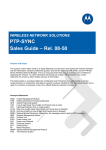Download Motorola PTP 300 Network Router User Manual
Transcript
PTP 300/500 Series Deployment Guide Contents Protect Your Installation ....................................................................2 Checklist, Site Survey and Tools ......................................................4 Bench Test and Configuration - Pre and Post-Power Checks ...........5 Bench Test and Configuration - Configuration Checks......................6 Hoist & Safety Loop...........................................................................7 Mast Installation Instructions .............................................................8 Wiring Diagram..................................................................................9 Recommended Cable Specification ................................................10 Cable and Gland Installation Notes .................................................12 Pre-Power Testing ...........................................................................13 Pre-Power Testing - Recording Resistance Values .........................14 Post-Power Testing and Fault Finding.............................................15 Installation and Commissioning.......................................................16 Registration Warranty and Ordering Information.............................19 License Keys and Regulatory Information.......................................20 Protect Your Installation Attention ElectroMagnetic Discharge (Lightning) Protect Your Installation! EMD (Lightning) damage is not covered under warranty The recommendations in this section and in the user manual, when followed correctly, give the installation the best protection from the harmful effects of EMD However 100% protection is not implied or possible The recommended components for protecting an installation are: • Solid screen Ethernet cable: Superior Essex type BBDGE. • Surge Arrestor: Type PTP-LPU - 2 per link – Part Number 2978 • Grounding Stake (if no suitable grounding point can be found). • Minimum 8 AWG Grounding Cable NB: There may be a local regulatory requirement to cross bond the CAT 5e cable to the mast at intervals as regular as every 10 metres (33 feet). This can be achieved using an Andrew grounding assembly type 223158 or similar. We recommend that the practices and procedures detailed in the Motorola manual R56 "STANDARDS AND GUIDELINES FOR COMMUNICATION SITES" (68P81089E50) be applied to all new site build activities. For a copy on the manual please see your local Motorola representative. The manual can be downloaded from the Motorola Intranet site http://compass.mot.com/go/190860869 2 Protect Your Installation Protection Requirements Zone A Recommended Zone A Zone A Zone B • Finial NOT Recommended Recommended Zone B Zone B Zone A – A direct strike is possible, mounting the ODU in this zone is not recommended. • Zone B –Indirect EMD (Lightning) effects are still possible, however, mounting within Zone B significantly reduces the possibility of a direct strike For further explanation and connection details see User Guide section - Lightning Protection Antenna cables should be grounded within 0.3 metres (1 foot) of the ODU and Antennas Antenna Cable Grounded to Tower Connectorized ODU Antenna Cable Grounded to Tower. Antenna Cable Antenna Cable Note: Antenna cables grounded using an Andrew grounding assembly type 223158 or similar. Antenna Cables Grounded to Tower Additional Grounding Requirements for Connectorized ODU 3 Checklist, Site Survey and Tools Before performing an installation of a Motorola PTP 300 or a PTP 500 Series system, ensure that you have read this entire guide and taken note of any safety information contained. Checklist • • Check the contents of all packages against the packing list. Check the Web site for the latest software load. List of special tools required • • • • • • • 13mm wrench and 22mm wrench for use with the glands. RJ45 Crimp Tool (Ensure you have the correct tool for the type of RJ45 being used). Personal Computer (PC) with 10, 100 or 1000BaseT Ethernet interface. Internet Explorer 6 or higher (recommended), or Firefox 2.0 or higher. Ethernet patch cables. Crimp tool for grounding lugs (only required when installing connectorized ODU). LINKPlanner report for this link. Pre-installation – Site Survey— Link Planning A site survey must be performed to identify all the obstructions (trees, buildings, etc) in the path and to assess the risk of interference. This information is important if you are to achieve an accurate link feasibility assessment. The PTP 300 and the PTP 500 Series are designed to operate in Non-Line-of-Sight (NLoS) and Line-of-Sight (LoS) environments. Link planning enables a link of known quality to be installed. This involves the acquisition of path profile data (using Motorola’s free LINKPlanner utility). The LINKPlanner predicts data rates and reliability over the path. It allows the user to try different antenna heights and RF power settings. When the link is installed the mean path loss can be checked to confirm that the predicted data rate and link reliability is achievable. Motorola LINKPlanner is available to download from http://www.motorola.com/ptp/support . Pre-installation – License Keys and Regulatory Conformity If the units have been purchased as a pair (link) then the License Keys (at the end of this guide or printed on a separate card in the box) will show how the units have been pre-configured to work as a link. Software, license key, unit’s IP address, subnet mask, gateway address, target address, master/slave and arming state are pre-configured. Check that the Link is configured with the correct region Code, otherwise you will need to re-configure the units with Alternative License Keys before installing and commissioning the link. Please refer to Page 6, Step 12 for details on how to change the License Key. 4 Bench Testing (Optional) - Connect and Power Up It is advised that the link be configured and tested on a bench before the final installation of the units on a pole or a mast. The following steps give details of how to connect an ODU to a PC in order to check the configuration details, change the IP settings or modify the license key. For the purpose of these tests, normal off-the-shelf Ethernet cables can be used. Step 1: Connect the RJ45 at one end of a cable to the ODU. Step 4: Put the cover back and tighten the screw. Step 6: Connect a second Ethernet cable (shown in yellow) to the “LAN” socket of the PIDU Plus. Step 2: Undo the retaining screw of the PIDU Plus and hinge back the cover. Step 5: Plug in power lead using a cable appropriate for the installation. NOTE - If the power LED does not illuminate, remove the power cable and the ODU connection from the PIDU Plus. Reconnect the power lead and check the power LED illumination (Green). If the power LED still does not light then check the power source. Step 7: 30 seconds after powering, the Ethernet LED should be observed to flash slowly 10 times. If the Ethernet LED does not illuminate (Orange), then either the PIDU Plus or the cable to the ODU may be faulty. Replace cable and/or PIDU Plus and repeat from Step 1. . Step 8: Ensure PC is set to correct IP address 169.254.1.x, where 2 < x < 254. Connect the LAN cable to the PC (shown here in yellow). 5 Step 3: Plug in the ODU to PIDU Plus Cable ensuring that it snaps home. Step 9: Check that the Ethernet LED is now ON. Refer to the Troubleshooting section in this guide if the LED does not show any activity when accessing web pages. Bench Testing (Optional) - Configuration Checks Step 10: Use a web browser to connect to IP address http://169.254.1.1 for Slave and http://169.254.1.2 for Master units. Select ‘System Administration’ and ‘Login’. (The password will be empty for new units). We recommend that you change the password by selecting ‘Change Password’ in the Menu bar. Step 11: You may wish to upgrade the software. If so, select ‘Software Upgrade’ and follow the on-screen instruction. Latest software is available from our web site: (http://motorola.motowi4solutions.com/software/#ptp) Step 12: Check the License Key information and ensure you are using the correct Region Code. Otherwise, select ‘License Key’ and replace with the alternative key supplied and reboot the unit. Step 13: Access the ‘Installation Wizard’, ’Wireless Configuration’ page . Confirm the target MAC Address, Master Slave Mode and other configuration choices. Reboot the unit. If testing connectorized ODUs, connect them together. Repeat steps 1-13 for the paired unit and check that the status of the link shows UP on the ‘Status Page’. 6 Hoist & Safety Loop Use the integral safety loop for hoisting the ODU up a mast or building. When the ODU is in position, use the safety loop as a fixing point to secure a permanent lanyard from the tower/ building to the ODU, as a precaution against mounting failure. Warning! The safety lanyard must not exceed 1 m (approx 3 ft) in length. The lanyard must be made from a material which does not degrade in an outdoor environment. Warning! The safety lanyard must be fixed to a separate fixing point which is not part of the direct mounting system for the ODU. Warning! If the safety loop or its fixing is damaged in any way or has been exposed to a shock loading due to a fall, replace it with a new one before undertaking any further operations. 7 Mast Installation Instructions Earth bonding lead Step 1: Your equipment will already have the mounting bracket fitted. Do not bracket. remove pre-fitted mounting The pre-fitted earth bonding lead is secured after the unit is mounted. Step 2: Attach the Bracket mount to the pole using the bracket strap and either M8 x 40mm or M8 x 70mm bolts, as required, M8 flat washers and M8 coil washers as shown. Tighten to ensure the assembly grips but can be adjusted. For poles between 1” (26mm) and 2”(50mm) reverse the bracket. Step 3: Offer up the unit to the bracket mount and affix using the captive M8 bolt. Tighten to ensure the assembly grips but can be adjusted on the pole. Attach free end (large tag M10) to Tower Metal work – NB On no account must this be attached to the mounting bracket bolts!! 8 Step 4: Adjust the elevation and azimuth of the unit before tightening to the required torque settings of 14Nm (11lbft) for both bolts. Warning ! Do not over tighten. Motorola PTP 300/500 Series Installation Wiring Lightning protection built into PTP xx500 or PTP xx300 Note the numbering of the pins in this diagram. 9 Correct cable preparation for the recommended cable Caution! Check that the correct crimp tool is being used for the RJ45 connector utilized. 10 Correct cable preparation for an example of a braided screened cable Note: Fit Gland to cable before fitting RJ45 Connector Housing Trim Conductors to edge of load bar (start with tails over-length to assist insertion into load bar) Connector load bar Inner cable sheath and braid terminate here Connector back shell Foil trimmed back to here 12mm 8 Brown 7 Brown/White 6 Green 5 Blue/White 4 Blue 3 Green/White 2 Orange 1 Orange/White 40mm 36mm min 45mm max. Cable braid trapped under connector back shell to prevent loose braid Cable Type; Connector Type; Crimp Tool; Gland; 11 CommScope 2003OD Tyco (AMP), 336330-1 Tyco (AMP), 790163-1 (Includes die set) Motorola WB1811 Cable and Gland Installation Notes Step 1: Make a cable as specified on Page 10 or 11. Plug in the RJ 45 into the ODU. Step 2: Support the drop cable and gently hand screw the gland body into the ODU until the O ring seal is flush to the ODU body. Caution Do not fit the back shell prior to securing the gland body. Step 3: Once the gland is fully hand screwed into the ODU it may be tightened to a torque of to 7 ftlbs/10Nm, with a 22mm wrench. Step 4:When the gland body has been fitted, tighten the gland back shell. Attention Do not over tighten the gland back shell Should it be necessary to disconnect the cable at the ODU (or PTP LPU), this can be achieved by removing the gland back shell first. Then, wiggle the cable to release the tension of the gland body as shown in the figure below. Then you can unscrew the gland body and depress the RJ45 locking tab with a small screwdriver. Gland on the right-hand side has been over tightened. As a result, the internal seal and structure have been damaged. 12 Apply small movements to the cable until you see a gap here before unscrewing the gland body. Pre-Power Testing Before plugging the RJ45 connector fitted to the lower LPU (or if not fitted the ODU) into the PIDU check the following resistances at the RJ45; a. Check the cable resistance between pins 1&2, 3&6, 4&5 and 7&8 at the RJ45. Check against column 2 in Table 1. b. Resistances for each pair should be within 1ohm of each other. c. Check the resistance between pins 1&3 and 4&7 at the RJ45. Check against column 3 and 4 in Table 1. d. Ensure that there is greater than 100K ohms between pins 1 & 8 for all cable lengths. e. Ensure that there is greater than 100K ohms between pin 1 and ODU ground for all cable lengths. f. Ensure that there is greater than 100K ohms between pin 8 and ODU ground for all cable lengths. Cat5E Length (meters) 0 10 20 30 40 50 60 70 80 90 100 Resistance between pins 1&2, 3&6, 4&5 and 7&8 (ohms) 0.8 2.5 4.2 5.9 7.6 9.3 11.0 12.7 14.4 16.1 17.8 Resistance between pins 1&3 (ohms) Resistance between pins 4&7 (ohms) 1.0 2.7 4.4 6.1 7.8 9.5 11.2 12.9 14.6 16.3 18 1.6 3.3 5.0 6.7 8.4 10.1 11.8 13.5 15.2 16.9 18.6 Table 1 - Resistance Table Referenced to the RJ45 at the PIDU Plus 8 1 Identification of pin 1 13 Pre-Power Testing - Recording Resistance Values Record the information listed in Table 2. This information will be useful if there is a need to contact Motorola Support or to identify future changes in the installation. Measure Resistance Between Pins Measured Measured IP Address LOCAL Resistance Value Resistance Value Link Name LOCAL LOCAL REMOTE MAC Address LOCAL 1&2 3&6 4&5 IP Address REMOTE 7&8 1&3 Link Name REMOTE 4&7 1&8 MAC Address REMOTE 1&ODU Ground 8&ODU Ground Table 2 : Record of Installation Measurements User Notes 14 Post-Power Testing and Fault Finding The correct operation is as follows 1. Connect the RJ45 to the PIDU Plus and apply power to the PIDU Plus, the green power LED should illuminate continuously. 2. 30 seconds after powering, the orange Ethernet LED should be observed starting with 10 slow flashes. 3. If there is a local network connection plus traffic the Ethernet LED will light solidly and flicker to show Ethernet activity. If the system does not operate correctly, refer to the fault finding guide below. Fault Finding Guide The PIDU green power LED does not illuminate Unplug the ODU connection from the PIDU and check the power LED illumination. If the power LED still does not light then check the power source. The PIDU green power LED flashes A flashing power LED indicates that there is a short circuit on the output of the PIDU. Check that pins 4&5 and 7&8 are not crossed with pins 1&2 and 3&6 on the RJ45, and check also that there is a resistance greater than 100K ohms between pins 1&8. The PIDU Ethernet orange LED flashes ten times but irregularly Irregularly flashing, seen as a short gap followed by a long gap, indicates that the ODU has booted in recovery mode. This can also indicate an installation wiring problem. The PIDU Ethernet orange LED flashes ten times but does not show Ethernet activity Failure of the Ethernet LED to show Ethernet activity can be due to wiring to pins 1&2 and 3&6 being incorrect, for example if the wiring to pins 1 and 3 are crossed. 15 Installation and Commissioning Before installing the units, Please ensure that any new obstacle has been entered in the LINKPlanner and that a new report has been printed. The Motorola PTP 300 and PTP 500 Series use audible tones to assist the installer with ODU alignment. The pitch (frequency) of the tone is relative to the received signal strength. The higher the received signal strength the higher the frequency of the tone emitted. Once the link is in the ‘Registered’ state optimum alignment is achieved by aligning for maximum frequency of the tone. If the link is affected by slow fading the frequency of the tone will vary. Under these conditions it is necessary to spend several minutes slowly adjusting the alignment to ensure the maximum average frequency is achieved. The meanings of the audible tones are shown in the table below: State Name Tone Description State Description Free Channel Search Regular beep Executing band scan. Scanning Slow broken tone Not demodulating wanted signal. Synchronized Fast broken tone Demodulating the wanted signal. Note: During acquisition there may be cycling between Scanning and Synchronized states until the alignment is sufficient to maintain the link up. If the fast broken tone disappears after 3 seconds, the unit may be pointing at the wrong PTP 500. Alternatively it may be detecting the correct PTP 300/500 but the signal is too weak to establish a link. Registered Solid tone Both Master and Slave units exchanging Radio MAC layer management messages. Table 3 - Audio indications from the ODU The term ‘wanted signal’ in the table above refers to that of the paired unit being installed. In each of the states detailed in the table, the unit should be aligned to give the highest pitch tone. It should be noted that if, when in the Synchronised or Registered states, the tone varies wildly, you may be suffering from interference or a fast fading link. Installing in this situation may not give a reliable link. The cause of the problem should be investigated before finalizing the installation. Due to the behavioural differences of Master and Slave units it is highly recommended that the Master unit is installed first and the initial alignment carried out at the Slave unit. Use the LINKPlanner report which provides installations notes such as bearing, tilt, power settings, antenna heights, etc. Once the optimum performance has been achieved by directing the Slave unit (indicated by highest frequency of tone or voltage output on the BNC connector of the ODU, which gives an indication of RX signal strength) then adjustment of the direction of the Master unit should be done without moving the Slave. Repeat as necessary at the Slave and then the Master until optimum alignment has been obtained. It is also possible to use the ‘Graphical Install’ from the main HTTP management interface. 16 Installation and Commissioning The following behavior should be noted: • • • • When first applying power and from time to time, the Master unit will carry out a band scan to determine which channels are not in use. During this time, between 10 and 15 seconds, neither unit will transmit. During this time the installation tone on both Master and Slave units will drop back to the Scanning state. The pitch of the tone will be proportional to the background noise level. Do not try to align the unit at this time. PTP 300 and PTP 500 Series do not require the user to enter the link range. The Master unit typically takes less than 60 seconds to determine the length of the link being installed. The Master unit will remain in the Scanning state until the length of the link has been established. The Master unit will only move to the Synchronized state when the length of the link has been established. If at the end of the ranging period the ‘Registered’ state is not achieved due to interference or other reasons, the Master unit will retry twice on the same channel before moving to another available channel. Should this occur it might take a number of minutes to establish a link in the ‘Registered’ state. The Slave unit does not have a ranging process. The Slave unit will change to the Synchronized state as soon as the wanted signal is demodulated. Additional Notes According to the LINKPlanner report power settings values, some additional steps are required. This is done to ensure that the power levels of the installed units are not too high. Higher power levels may cause the saturation of the receivers or may cause false Radar detection (in Radar Enabled regions) which will cause a degradation of the link performance and may be responsible for a link failure. The following procedure describes the additional steps required. 1. 2. 3. 4. 5. 6. 7. 8. Consult the report generated by the LINKPlanner tool and note the Transmit power recommended levels. Set the local unit power equal to the “LOCAL - Max Transmit Power setting while pointing” value from the LINKPlanner report. Set the remote unit power equal to the “REMOTE - Max Transmit Power setting while pointing” value from the LINKPlanner report. Access each unit separately. Align the units as described in the User Guide. Repeat Step 2 and 3 using the values “LOCAL - Max Transmit Power setting before disarm” and “REMOTE - Max Transmit Power setting before disarm” , if different than the corresponding “while pointing” values. Reboot the local unit then reboot the remote unit. Disarm the units. 17 Installation and Commissioning Finalize the Installation When the alignment process is complete the installer must remember to disarm both units in the link as described in the handbook. On disarm, the radio may automatically reduce the Transmit power to cope with short range operation. This is necessary for the following reasons: • • • To turn off audible alignment aid. To enable Adaptive Modulation. To clear unwanted installation information from the various systems statistics, and to store the link range for fast link acquisition on link drop. Take note of the following items for future reference: • • • • • • Save a copy of the configuration using the “Save and Restore” functionality found under the “System Administration – Configuration” menu. Take a screen shot or print of the status page. Note the position and orientation of the antenna, and Note surrounding objects that may interfere with the link. A photograph is recommended. After 1 hour of operation the mean value of Link Loss on the status page should be within the values given in the LINKPlanner report. Further adjustments of the power levels may be necessary, so please consult the LINKPlanner report notes and adjust the powers accordingly. You will not be required to reboot the units for that to take effect. The LINKPlanner may need re-running to account for new known obstacles any time during the operation of the link. Note that for short ranges and for links installed when Radar is Enabled, the PTP 300 and PTP 500 Series software will adjust automatically the maximum Transmit Power when the unit is disarmed. For further information about Motorola PTP 500 Series refer to the User Guide on the CD or from the PTP website : http://www.motorola.com/ptp 18 Registration Warranty and Ordering Information The PTP 300 and the PTP 500 are each an extraordinarily robust radio communications link with unsurpassed availability and reliability. Along with your Motorola PTP Bridge you get a 12month Standard Warranty that provides a 30-day repair-and-replacement program for hardware defect failures and minor software enhancements as they become available. Although our bridges are extremely robust even in severe weather conditions, equipment failures can occur. We, therefore, recommend that you consider upgrading your first-year Standard Warranty to a PTP Extended or PTP “All Risk” Advanced Replacement Warranty. Extended Warranty extends your initial 12-month standard hardware warranty through the second, third or fifth years of ownership, providing 30-day repair and return for defective parts. Advanced Replacement Warranty proposes up to five years of cover with next-business-day shipping of replacement equipment. Our Advanced Replacement warranties provide “All Risks” cover including:• • • • Lightning Damage. Damage – caused by improper wiring, electrical shorts, building fires, vandalism. Dropped Units. Component or manufacturing defects. With our warranties, you have peace-of-mind knowing that your investment is fully protected and, if you are covered with the Advanced Replacement Warranty, your communications will be back in operation in the shortest time possible. Register Your Units to receive updates and activate your warranty Upon receipt of your new PTP link, you should register your units to activate your free standard 12-month warranty and receive notification of software updates. For convenience, you can do that online at www.motorola.com/ptp/support/registration Item Part Number 1 Year PTP Software Support Contract (1-2 Links) WB3106 1 Year PTP Software Support Contract (3-5 Links) WB3107 1 Year PTP Software Support Contract (5+ Links) WB3108 2nd Year Extended Year (30 Day Return & Repair) WB3133 3rd Year Extended Year (30 Day Return & Repair) WB3134 5th Year Extended Year (30 Day Return & Repair) WB3135 Upgrade 1st year 24hr Advanced Replacement “All Risks” WB3136 Upgrade 2nd year 24hr Advanced Replacement “All Risks” WB3137 Upgrade 3rd year 24hr Advanced Replacement “All Risks” WB3138 Upgrade 5th year 24hr Advanced Replacement “All Risks” WB3139 19 License Keys and Regulatory Information Unit A1, Linhay Business Park Eastern Road, Ashburton Devon, TQ13 7UP, UK Telephone Support: +1 877 515-0400 (Worldwide) +44 808 234 4640 (UK) http://www.motorola.com/ptp MOTOROLA, the stylized M Logo and all other trademarks indicated as such herein are trademarks of Motorola, Inc. ® Reg. US Pat & Tm. Office. All other product or service names are the property of their respective owners. © 2006-2008 Motorola, Inc. All rights reserved. Doc Ref: phn1146_003v000 20































